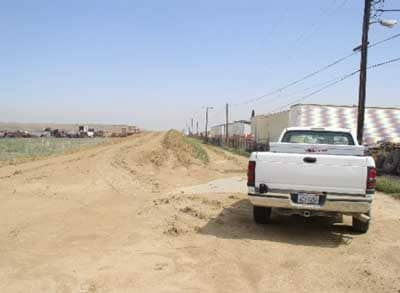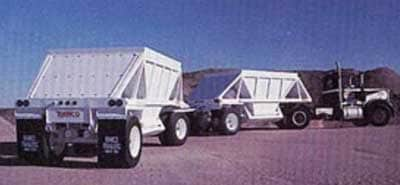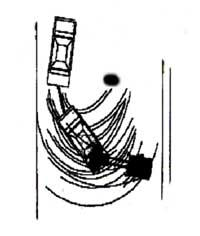An Equipment Operator Died After Being Run Over By A Double Trailer Truck
Investigation: # 03CA009
SUMMARY
A 32-year-old Hispanic male equipment operator died when he was run over by the rear tires of a bottom-dump, double trailer truck. The truck was completing a U-turn when the incident occurred. The victim got off of his equipment and walked over to the truck in order to give the driver instructions as to where to dump his load. The driver of the truck thought the victim was at a safe distance from the truck, so he never looked back as he completed his U-turn. The CA/FACE investigator determined that in order to prevent future occurrences, employers, as part of their Injury and Illness Prevention Program (IIPP), should:
- Ensure that truck drivers only make turns when they are sure pedestrians will not be within the turning radius of any part of their truck.
- Ensure that standard operating procedures are developed, implemented, and enforced for worksites where there may be workers on foot in the vicinity of moving vehicles.
INTRODUCTION
On November 19, 2003, at approximately 8:15 a.m., a 32-year-old male equipment operator died when a bottom-dump semi-trailer was completing a U-turn. The CA/FACE investigator learned of this incident on December 4, 2003, through the Legal Unit of the Division of Occupational Safety and Health (Cal/OSHA). On December 11, 2003, the CA/FACE investigator made contact with the employer of the victim. On March 22, 2004, the CA/FACE investigator traveled to the victim’s place of employment where he interviewed the plant manager. Pictures of the incident scene were taken, and other related documents were reviewed.
The employer of the victim was a producer of ready-mixed concrete and construction aggregates that had been in business for 26 years. The company had 2,500 employees, with 22 employees working at the facility where the incident took place. The victim had been employed with the company for three years and had worked at the incident site for three months. The victim was employed as a universal equipment operator. He was capable of operating numerous pieces of heavy equipment such as motor graders, bulldozers, front-end loaders, and dump trucks. The driver of the truck involved in this incident had a valid driver’s license and his commercial license and medical examination were also current. There were no restrictions to his license.
The employer of the victim had a written safety program and an IIPP. There were site-specific hazard awareness forms available for the jobs performed by the victim at the site. They had been updated in July 2003. Safety meetings were held weekly and documented. The company had a written training program. Employees were trained on the specific hazards of their job and were given written tests of their knowledge.
INVESTIGATION
The site of the incident was an asphalt road that was being used as a temporary storage site for a mixture of dirt and clay that was to be used later at an adjacent garbage dump site. The dirt was being dumped on one side of the road in the shape of a berm that measured approximately four feet high at the time of the incident (Exhibit #1). The bottom-dump trucks would drive on top of the dirt berm, dump their loads, and then head back along the other side of the road to get another load. The grader, driven by the victim, would level off the dirt so the trucks could continue to drive on it.
The vehicle involved in this incident was a tractor with two trailers (Exhibit #2). The tractor was a cab-over, two-axle with a gross vehicle weight (GVW) of 32,000 pounds. The first trailer was a bottom-dump, single-axle with a GVW of 35,000 pounds. The second trailer was a bottom-dump, two-axle, with a GVW of 40,000 pounds.
On the day of the incident, the victim was assigned to operate the grader and level out the dirt the trucks were dumping on the top of the berm. A truck pulling two bottom-dump trailers dumped his last trailer, and then proceeded off the berm at the end of the berm where the grader was parked. The victim was standing on the ground near the grader. The truck then proceeded to make a left-handed U-turn. Halfway through the U-turn, the driver of the truck stopped. The victim walked up to the driver’s door and told the driver to circle back and dump the other trailer behind the load he just dumped. The victim then stepped away from the truck. After the truck driver saw the victim step away from the truck, he completed his U-turn, and then drove back alongside the berm. The victim was struck by the left-side tires of the last trailer. The truck driver was unaware of the collision until he was flagged down by another driver. The paramedics were called, and the victim was transported to a hospital where he was pronounced dead.
CAUSE OF DEATH
The cause of death, according to the death certificate, was blunt force injury of head and torso.
RECOMMENDATIONS/DISCUSSION
Recommendation #1: Ensure that truck drivers only make turns when they are sure pedestrians will not be within the turning radius of any part of their truck.
Discussion: Pedestrian traffic in a busy truck route can be a serious safety hazard. The operation of heavy equipment and trucks requires intense concentration. Notwithstanding the noise and dust created by the operation, the drivers must pay close attention to the work being performed. While pedestrians should be aware of their surroundings and take care to stay clear of equipment, truck drivers and equipment operators have the primary responsibility for preventing pedestrian injuries or death.
In this incident, the rear wheels of the truck followed a very different path than the front wheels. The path of the rear wheels followed a much smaller “radius.” This is known as off-tracking. This off-tracking makes it possible for objects that are at a considerable distance from the front of the truck to be hit by the rear of the truck during turns (Exhibit #3). The truck driver completed his turn while the victim was still in the area where he could be hit. The driver stated that he never felt or heard anything unusual after he completed his U-turn. He accelerated from the incident scene without even knowing he had run over the victim. Had the driver waited until the victim was completely clear of the trucks path before moving, this incident might have been prevented. Employers can ensure worker compliance with safe work practices through continued documented programs of training, supervision, safe work recognition, and progressive disciplinary measures.
Recommendation #2: Employers should develop, implement, and enforce standard operating procedures (SOPs) for worksites where there may be workers on foot in the vicinity of moving vehicles.
Discussion: Workers on foot are at risk of being struck or run over in worksites with moving vehicles. After a hazard assessment identifies the hazards specific to a worksite, SOPs can help to control those hazards. Whenever possible, projects should be engineered so that workers on foot are not assigned tasks that require them to work near moving vehicles. When this is not possible, SOPs should require at a minimum that: drivers and workers on foot hold pre-work meetings to review the procedures for the tasks; the work done on foot near moving vehicles is minimized; drivers only leave their vehicles at certain pre-determined locations; workers wear high visibility vests; communication be continuous; and workers on foot stay out of blind spots and at predetermined distances from moving vehicles.
REFERENCES
- California Code of Regulations, Title 8, 1592(e)
FATALITY ASSESSMENT AND CONTROL EVALUATION PROGRAM
The California Department of Health Services, in cooperation with the California Public Health Institute, and the National Institute for Occupational Safety and Health (NIOSH), conducts investigations on work-related fatalities. The goal of this program, known as the California Fatality Assessment and Control Evaluation (CA/FACE), is to prevent fatal work injuries in the future. CA/FACE aims to achieve this goal by studying the work environment, the worker, the task the worker was performing, the tools the worker was using, the energy exchange resulting in fatal injury, and the role of management in controlling how these factors interact.
NIOSH funded, state-based FACE programs include: Alaska, California, Iowa, Kentucky, Massachusetts, Michigan, Minnesota, Nebraska, New Jersey, New York, Oklahoma, Oregon, Washington, West Virginia, and Wisconsin.
To contact California State FACE program personnel regarding State-based FACE reports, please use information listed on the Contact Sheet on the NIOSH FACE website. Please contact In-house FACE program personnel regarding In-house FACE reports and to gain assistance when State-FACE program personnel cannot be reached.
EXHIBITS



